 |
Citrus Growers Forum
This is the read-only version of the Citrus Growers Forum.
Breaking news: the Citrus Growers Forum is reborn from its ashes!
Citrus Growers v2.0
|
|
|
|
How to force a citrus to put out new leaves?
Goto 1, 2 Next
|
| Author |
Message |
Evaldas
Citruholic

Joined: 30 Jan 2010
Posts: 303
Location: Vilnius, Lithuania, Zone 5
|
| Posted: Mon 04 Jul, 2011 12:18 pm |
|
What would I need to do if I wanted a citrus, that hasn't put out any new leaves in 5 months, to do that now? (It's summer here) |
|
| Back to top |
|
 |
Laaz
Site Owner


Joined: 12 Nov 2005
Posts: 5664
Location: Dorchester County, South Carolina
|
| Posted: Mon 04 Jul, 2011 12:47 pm |
|
Fertilize & and make sure the roots are warm.
_________________
Wal-Mart a great place to buy cheap plastic crap ! http://walmartwatch.com/ ...
 |
|
| Back to top |
|
 |
RyanL
Citruholic


Joined: 07 Jan 2010
Posts: 409
Location: Orange County, North Carolina. 7B
|
| Posted: Mon 04 Jul, 2011 9:58 pm |
|
If the tree has fruit remove it, this will free up energy for foliage growth. |
|
| Back to top |
|
 |
Millet
Citruholic


Joined: 13 Nov 2005
Posts: 6657
Location: Colorado
|
| Posted: Tue 05 Jul, 2011 12:54 am |
|
Ryan is generally correct (and by the way Ryan, the trees you posted on another thread were very nice healthy looking trees -- Great Job). To the point of this thread, many new growers eagerly look forward to the day when they can pick their first fruit from their tree, and therefore dislike removing any fruit in an effort to obtain growth of their small tree. Recently reading a Purdue University article on citrus growing, the article pointed out that it is OK to leave a fruit on a young growing citrus tree. Reading on, the article stated that one fruit will not delay in any way the growth of the tree. This is because a fruit requires the energy of only 3 leaves to bring the fruit to maturity. - Millet (561-) |
|
| Back to top |
|
 |
Karoly
Citruholic

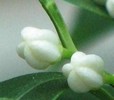
Joined: 27 Dec 2010
Posts: 230
Location: Hungary, Europe, Zone 6
|
| Posted: Tue 05 Jul, 2011 3:29 am |
|
Usually I leave the tree to select the fruits (drop off) but we know that not all citruses do that. If the tree stops to grow new twigs, then I start to remove one fruit every 2 weeks until the tree start to grow again.
Here is an example of lemon where taking in consideration the trunk diameter which is a bit thicker then a pencil, it have 9 lemons, drop off 4 and start to grow 5 fruits but in the last 2 months the tree doesnt grow absolutely nothing. One week ago I remove the first fruit and now it start to grow again. The 5 fruit took too much energy from the tree and couldnt develop any new twigs.
Evaldas, your tree is growing any fruit?
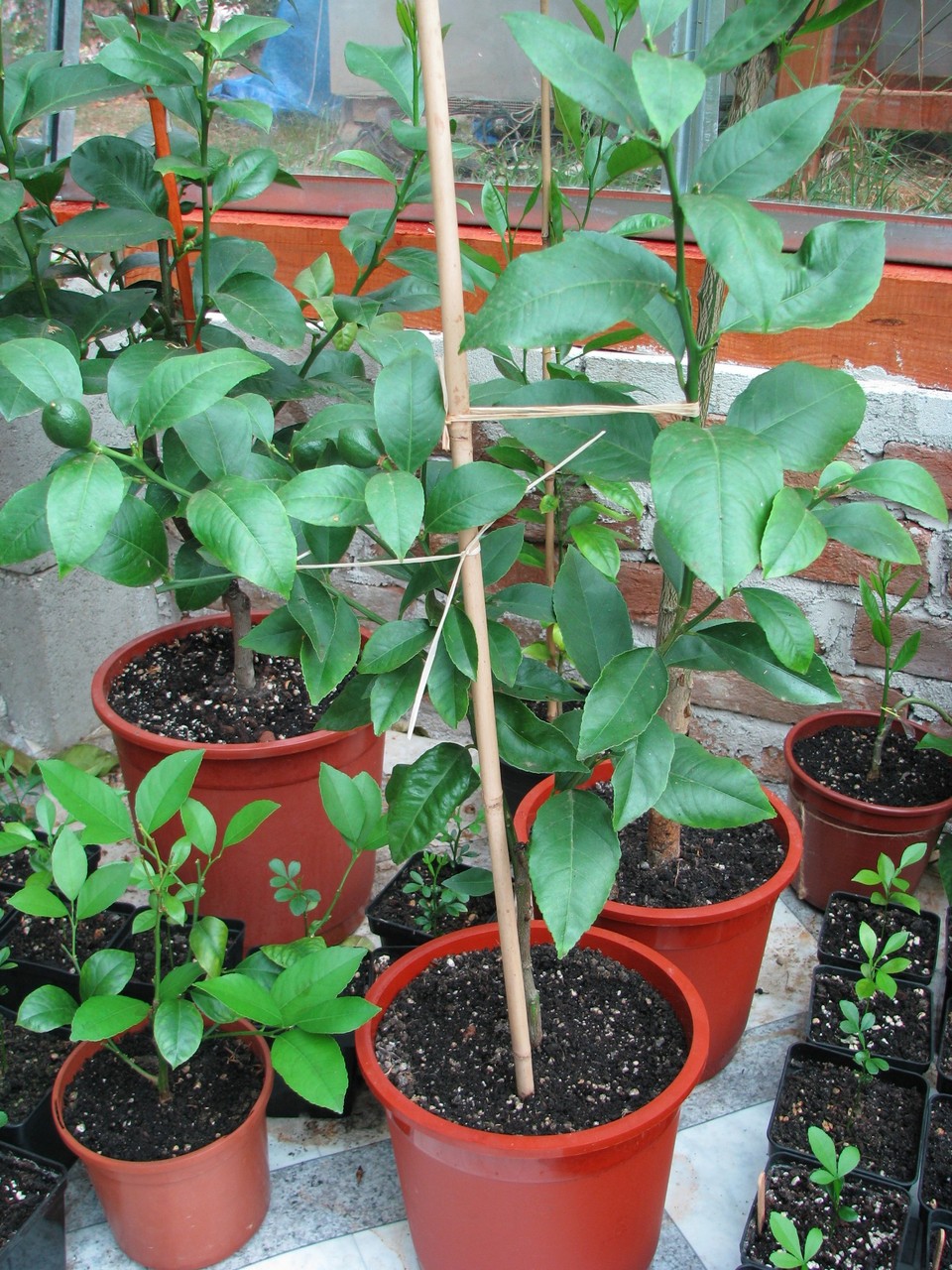
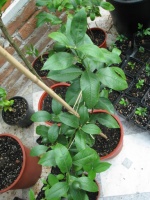
Evaldas, your tree is growing any fruit? |
|
| Back to top |
|
 |
Evaldas
Citruholic

Joined: 30 Jan 2010
Posts: 303
Location: Vilnius, Lithuania, Zone 5
|
| Posted: Tue 05 Jul, 2011 10:25 am |
|
The trees are both Eustis Limequats. One is in a 12 cm diameter pot, the other - 15 cm. One tree (in a 12 cm pot) is blooming right now (seems to be doing just that for the past five months) and actually has 3 new growing leaves (but that seems little).
About a month ago I took off all the fruit from the other tree (in a 15 cm pot) but it still does nothing.
Take a look:
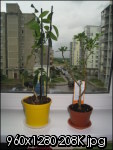 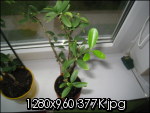
I've also pruned both of the trees quite heavily, but it didn't help.
Both of these trees in the winter time had been growing under grow lights, maybe that has something to do with that?
I start to believe that it is true that some citrus varieties are easier to take care of, I didn't believe this before. My Calamondins are growing putting out new leaves often without a problem...
I repeat, both of these Limequats haven't put out any new leaves (except for 3 leaves that are growing right now on one of the trees) in 5 months. |
|
| Back to top |
|
 |
Malcolm_Manners
Citrus Guru

Joined: 13 Nov 2005
Posts: 676
Location: Lakeland Florida
|
| Posted: Tue 05 Jul, 2011 1:29 pm |
|
I think some clarification of the physiology of bud flushing may be helpful here. Statements above are correct, but I think they may be leading to the wrong conclusions. Its quite true that a fruit gets its energy from only about 3 leaves. Its also true that the presence of fruit may delay flushing. But this is NOT because of energy being taken or used by the fruit (another fun fact -- oranges take virtually no caloric energy from the tree after they reach golf-ball size -- the tree just pumps in water after that). Rather, it is the fact that the fruit is a source of auxin (indole-3-acetic acid) that causes the inhibition of flushing.
A bit of background here, on the nature of bud dormancy and bud growth: There are two competing hormones controlling the situation. The first is auxin, which is produced by fruit, flowers, leaves (especially young, expanding ones), and vegetative buds. This auxin is shipped downward via parenchyma cells among the phloem tissue. Axillary buds along the stem in some way perceive the passage of auxin downward, behind them, in the stem. As long as the flow of auxin is adequate, those buds will remain dormant. This is known as apical dominance, in that it is generally the bud or 2 at the end of a branch that grows, on most plants, while lower buds remain dormant; hence, the apex is dominant over those lower buds. This is easily demonstrated by pruning a branch at any point. Almost immediately, the next bud down from the cut will begin to grow, even though it may have remained dormant for years, until the cut was made. It is the sudden loss of that stream of auxin that told it to grow.
The other hormone involved is a cytokinin (mostly zeatin and perhaps some dihydrozeatin, in most plants), being produced by the roots and sent upward into the branches. Cytokinin stimulates bud break and flushing. So there is always a competition there -- cytokinin is telling the bud to grow, whereas auxin is telling it to wait a while. At any given moment, one message or the other is winning, and the bud will behave appropriately. So when the auxin flow decreases, the bud immediately begins to respond to the ongoing cytokinin message.
Back to the original subject here -- existing fruit. While they may be taking little or no sugars or other energy from their branch, they do serve as an ongoing and powerful source of auxin, so as long as they are present, there is a reduced likelihood of growth of the buds lower down on that branch. We also see this with blossom blight or post-bloom fruit drop disease, caused by Colletotrichum acutatum. It causes the petals of the flower to rot, then the tiny fruitlet abscisses. However, the calyx does not fall from the tree as it normally would, and instead, it swells and remains green. This calyx button is a powerful inhibitor of growth from subtending buds, and is part of the cause of damage to the tree -- not only did you not get a fruit from that flower, but that branch wont grow again for many months, until the calyx finally dies.
On the other hand, fruit has this auxin effect only on buds located on the same branch, lower down on the branch. They have little or no effect on other, non-fruiting branches of the tree. So assuming the tree has a healthy root system (source of cytokinin) and the tree has adequate water and fertilizer, those branches should flush regularly. On a young tree, that may be every 8-10 weeks; less often on older, larger trees. |
|
| Back to top |
|
 |
bastrees
Citruholic

Joined: 16 Jun 2007
Posts: 232
Location: Southeastern PA
|
| Posted: Tue 05 Jul, 2011 1:46 pm |
|
Wow, I'm going to snip off my empty calyxes right now. Most of my meyers lemons that reach the size of a small grape and then yellow and fall will leave the calyx behind. The ones that flower and drop immediately drop the whole flower bud. I was pondering this difference a few days ago. Most of my fruit appear to be at the size where they will continue to grow to maturity, but there are a few stragglers that do not appear to be gaining size that I think will ultimately be shed.
Dr. Manners, I know this subject had been raised before, but what are your thoughts on spraying cytokinins on the branches to affect the relative influence of the competing hormones?
Thanks for the info,
Barbara |
|
| Back to top |
|
 |
Karoly
Citruholic


Joined: 27 Dec 2010
Posts: 230
Location: Hungary, Europe, Zone 6
|
| Posted: Tue 05 Jul, 2011 2:09 pm |
|
Dr. Manners,
Thank you very much for these very usefull informations. |
|
| Back to top |
|
 |
Millet
Citruholic


Joined: 13 Nov 2005
Posts: 6657
Location: Colorado
|
| Posted: Tue 05 Jul, 2011 5:42 pm |
|
Previously posted above. >>>>>>" Recently reading a Purdue University article on citrus growing, the article pointed out that it is OK to leave a fruit on a young growing citrus tree. Reading on, the article stated that one fruit will not delay in any way the growth of the tree. This is because a fruit requires the energy of only 3 leaves to bring the fruit to maturity.<<<<<<<<<<<<
Purdue University does not go into all the detail that Dr. Manners provided for us concerning the auxins and cytokinins involvement on the flushing of a citrus tree. Therefore, to mesh Dr. Manners post with Purdue's post see below. Purdue says one fruit will not affect the growth pattern of a young citrus tree, which I feel is still true. However, as advised by Dr. Manners a fruit remaining on a tree can affect the flushing of that particular branch the fruit is attached to. Therefore, if a grower wishes to retain a fruit until maturity on a young tree, just note that that particular branch will not flush, but the balance of the tree will not be affected and should flush according to nature's system. I remember back when I was growing my very first citrus tree, how anxious I was to pick and eat my first fruit. Personally, now knowing what Dr. Manners told us in the above post, I would have gladly sacrificed the growth of one branch to keep my choicest orange. - Millet (560-) |
|
| Back to top |
|
 |
Malcolm_Manners
Citrus Guru

Joined: 13 Nov 2005
Posts: 676
Location: Lakeland Florida
|
| Posted: Tue 05 Jul, 2011 7:39 pm |
|
Barbara, Certainly, spraying cytokinins on a branch can promote flushing. But I'm not aware of any cytokinins labeled for use on citrus trees for that purpose. Kinetin and 6-benzylamino purine have both been shown to have that effect in other plants. |
|
| Back to top |
|
 |
bastrees
Citruholic

Joined: 16 Jun 2007
Posts: 232
Location: Southeastern PA
|
| Posted: Wed 06 Jul, 2011 10:42 am |
|
Dr. Manners, your explanation reminded me of a thread that I found when I was introduced to the term "cytokinin" when trying to find GA in a tomato blossom set. Millet had indicated that tomato blossom set contained GA, but the formulation must have changed or the product that he referred to is not available to me locally. My blossom set for tomatoes contains the active ingredient "cytokinins". When I searched this forum I found this thread:
link
Your explanation gave me a better understanding of the competing hormones. As a result, I wondered if a topical application of hormones, rather than normally occurring hormones administered naturally through the root system, would affect the tree as quickly as is implied in the referenced thread, or if coincidence and timing are more at play.
Barbara |
|
| Back to top |
|
 |
Malcolm_Manners
Citrus Guru

Joined: 13 Nov 2005
Posts: 676
Location: Lakeland Florida
|
| Posted: Wed 06 Jul, 2011 1:29 pm |
|
Applied cytokinin, assuming it is absorbed into living tissue, should cause cell division (mitosis) to begin almost immediately. And it would also immediately overwhelm the auxin-based apical dominance. So I would not be surprised at an almost immediate response.
I did notice on the other thread the idea that 6-BAP should be safe for humans since it is very close, chemically, to natural cytokinins. While I don't have any reason to believe that it is not safe, I think that is not valid logic as to why it should be safe -- many of the poisons and carcinogens that affect us do so precisely because they are very close to some natural, normal material in the body, for which they substitute, but once substituted, they don't work quite like the real thing.
Also, the other thread indicated a level of safety because the 6-BAP would not be absorbed into the plant. In order to have an effect, it must be absorbed. So if not absorbed, it won't work; if absorbed, then yes, it is now inside the plant.
I have no reason to think 6-BAP would be in any way harmful, if used on citrus. However, it is not labeled for such use, so I'd not use it. It is labeled for use on apples in Canada, so it must be considered safe for food crops, but I'm not aware that it is used on any food crop in the US. We do allow the Canadian apples to be sold in the US, so in that sense, USDA and EPA must consider it safe. |
|
| Back to top |
|
 |
tidusid
Citruholic


Joined: 25 Oct 2010
Posts: 71
Location: League City, 9A, South of Houston, TX
|
| Posted: Thu 07 Jul, 2011 12:14 am |
|
Hold it at gunpoint until it give in to your demands. |
|
| Back to top |
|
 |
Darkman
Citruholic

Joined: 20 Jul 2010
Posts: 968
Location: Pensacola Florida South of I-10 Zone 8b/9a
|
| Posted: Thu 07 Jul, 2011 12:15 am |
|
Dr. Manners,
Thank you for the excellent information. My question is if we manipulate the top growth how does that effect root growth? Will it naturally balance? On my new young trees I want the roots to develop quicker than the top. Are there any issues with pushing top growth?
_________________
Charles in Pensacola
Life - Some assembly required, As is no warranty, Batteries not included, Instructions shipped separately and are frequently wrong!
Kentucky Bourbon - It may not solve the problem but it helps to make it tolerable! |
|
| Back to top |
|
 |
| Informations |
 |
Our users have posted a total of 66068 messages
We have 3235 registered members on this websites
|
| Most users ever online was 70 on Tue 30 Oct, 2012 10:12 am |
Powered by phpBB © 2001, 2005 phpBB Group
|
|



























